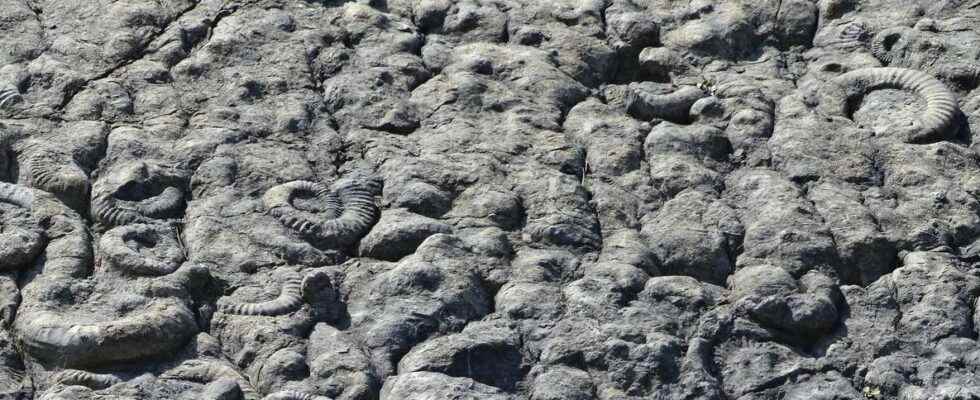Emblematic site of the Haute-Provence geological nature reserve, the Dalle aux ammonites de Digne has an impressive concentration of fossils. In what environment did these Jurassic marine animals settle? Is such a concentration normal or associated with a particular event?
You will also be interested
[EN VIDÉO] Discover the Estérel, between the Mediterranean and Provence In the Estérel, a superb 32,000 hectare massif, between the Mediterranean Sea and Provence, walks are full of surprises. It borders the municipalities of Saint-Raphaël, Fréjus, Bagnols-en-Forêt and the Adrets de l’Estérel. Not to mention that Futura’s offices are located in the heart of the Estérel …
Located on the right bank of the Bléone, about 1.5 km north of the town of Digne-les-Bains, on the road leading to Barles, la dalle aux ammonites has become one of the emblematic sites of the Haute-Provence geological nature reserve.
The Digne ammonite slab, an exceptional site
On an inclined slab of 320m2 there are more than 1,550 ammonite fossils, particularly large. The largest are indeed about 70 cm in diameter. 90% of ammonites observed on the slab belongs to thespecies Coroniceras multicostatum, which colonized the marine space during the Sinemurian (Lias, Jurassic lower, 198 million years old). There are also some rare fossils of nautilus, belemnites, pectens and others bivalves.
The slab enclosing the fossils is part of a succession of fine-grained limestone beds or very compact clayey limestone, separated by fairly fine marly interlits. These are limestone sedimentary deposits deposited during the Lias in an ocean basin a few hundred meters deep, below the action limit of waves of storms.
The slab ammonites de Digne was discovered in the early 1940s during road works. It will then be gradually released to finally obtain a outcrop spectacular 17 x 19 meters. Today it is protected and enhanced.
A mine of geological information
This site is remarkable for its abundance of ammonite fossils. Ammonites are mollusks cephalopods who populated the oceans of the Earth over a very long period of time, Devonian (-400 million years), until the end of Cretaceous (-66 million years old). Their disappearance is associated with the Cretaceous-Tertiary crisis, which also caused extinction of dinosaurs. Marine animals, ammonites are the distant ancestors of octopuses, dry and squid. They had a shell univalve more or less coiled on itself and were provided with 8 or 10 arms. Their sizes and shapes have changed and evolved a lot over millions of years, making them excellent chronological markers.
The peculiarity of the ammonite slab of Digne is that it has a very low biodiversity, largely dominated by the species. Coroniceras multicostatum. The slab actually represents the fossilized surface of a seabed more than 190 million years old. The spectacular accumulation of shells, often large and highly ornate, has provided a better understanding of the evolution of the species. Coroniceras multicostatum over time. It also tells us about the environmental conditions at the time.
When the dead ammonites are deposited on the sedimented bottom, the Alps did not exist. Instead, an ocean, resulting from the fragmentation of the super-continent Pangea, was opening. It will be closed much later by the game of tectonic plates, and sediments deposited millions of years ago will find their way onto the continental crust by the obduction process leading to the alpine chain formation.
The ammonites present on the slab tell us that in Lias, 198 million years ago, the sea was teeming with life. The marine environment was stable, with water at salinity constant allowing the development and installation of a wildlife perennial marine. The almost exclusive presence of Coroniceras multicostatum suggests that this species must have been largely dominant in the region’s ocean basins during the Lower Sinemurian. These basins are in fact often characterized by relatively undiversified fauna.
Normal mortality or mass extinction?
The very high concentration of fossil on the slab, however, raises a question: is this accumulation of shells normal or associated with a particular event, such as a mass extinction or to transport processes?
The good preservation of the fossils shows that the shells were deposited in a calm environment, far from the coast, sheltered from the action of waves, currents and storms which would have tended to rearrange and fragment them. The ammonites are also not oriented in a particular way and nothing attests to the role of a current which could have led to their accumulation in a particular place. In addition, the paleo-environmental conditions of the Sinemurian do not support the hypothesis of a mass extinction at that time.
Studies of intraspecific variability of Coronicera multicostatum suggest on the other hand that the deposit period was relatively short – geologically a few hundred thousand years ago. Although the discussion remains open, it would therefore seem that the high concentration of ammonites in the Digne slab is only the result of the normal mortality of a certainly large population of Coronicera multicostatum, associated with rates of sedimentation rather weak, not allowing the shells to be buried as they were deposited on the bottom.
Interested in what you just read?
.
fs12
